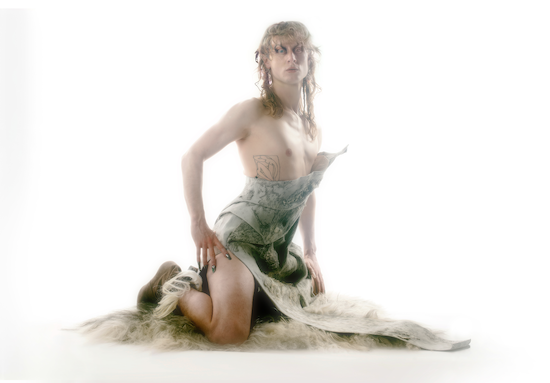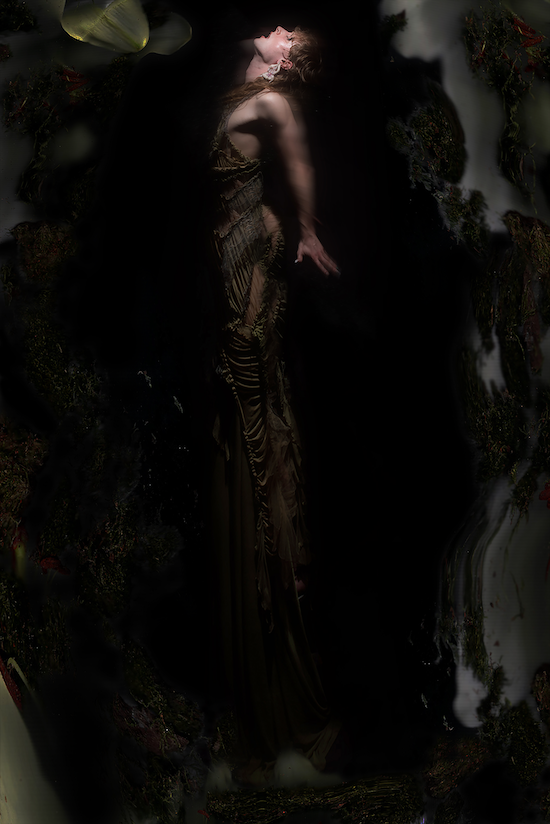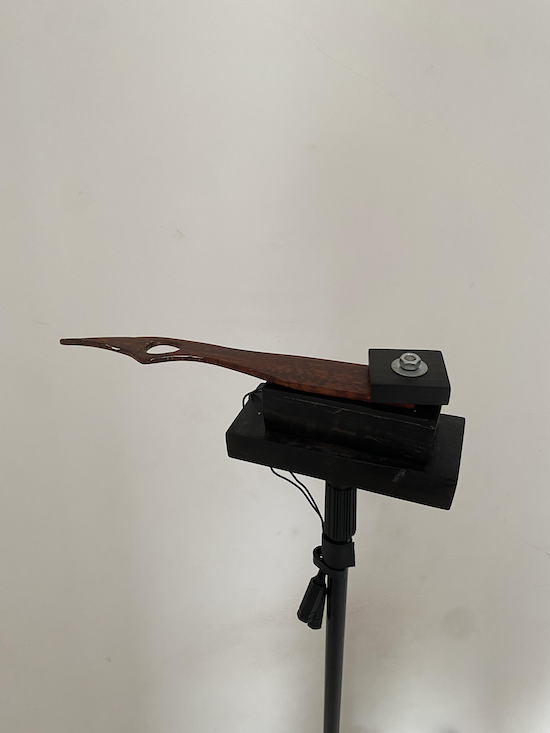Photos by Luke Tubbs
In Sarahsson’s debut album The Horgenaith, the beautiful and grotesque are constant companions. Opening track ‘Ancient Dildo Intro’ sends the listener hurtling through lurching, cavernous industrial (as if travelling through the bowels of an enormous cyborg) before breaking, with a series of sucking sounds, into a gorgeous piano prelude accompanied by tweeting songbirds.
Marrying her childhood background in classical music with elements of metal, hardcore and heavy electronica, the composer has quickly marked herself out as an exciting new force in Bristol’s thriving avant-garde. Created with a grant from local initiative Saffron, The Horgenaith was released by Illegal Data: a label and club night run by DJ NE$$ and Giant Swan’s Harry Wright, which since 2018 has hosted some of the most bracing, electrifying live music in the city.
Raised in Exeter, Sarahsson moved to London as a teenager before arriving in Bristol, considering it a cultural halfway point between the two cities. “There’s a nightlife and queer scene, but it’s not going to burn you out,” she explains. She had already secured an early break making music for fashion label Neith Nyer, including their runway shows at Paris Fashion Week. “I first DJ’d as Sarahsson at the afterparty. The artists I was interested in at the time were men using their given names, like Marcel Dettmann and Robert Hood, and I figured my birth name Felix Dobson didn’t have that same ‘techno man’ ring to it” she laughs. “My surname is an Old English contraction meaning ‘son of Robert’, so I used my mum Sarah’s name as a matriarchal twist.”
I first saw Sarahsson perform at Bristol metal pub The Gryphon. Appearing with a feathery white shawl, enormous combat boots and flowers glued to her cheeks, the set principally saw her lip-sync to a violently eclectic mix spanning noise and nightcore. Ripping off the shawl to dance in a leather garter, and cartwheeling out of the combat boots to reveal a pair of high heels worn inside them, she then performed a piece on a tenor horn, before plunging one of the flowers into her throat and tossing the saliva-drenched stem to an audience member. While Sarahsson’s sets have evolved to employ more live instrumentation, including a bowed daxophone instrument she built herself, they remain startlingly unpredictable. “To this day, I’ve never rehearsed a set” she grins.
In this spirit, The Horgenaith is gleefully volatile in approaching its weighty themes: bodily transformation, femininity’s cultural proximity to nature, and Sarahsson’s own experiences as a non-binary transfemme. The plaintive vocals of ‘Tonsil Pearls’ swell into a thumping EBM freak-out. Lush piano in ‘Perennium (Reprise)’ cuts to a near minute of silence, before the listener is fried in the opening crackle of noise monster ‘Orchidectomy’. As the triumphant synths of album-closer ‘Cladonia Hymnal’ are finally vaporised by a wave of distortion, The Horgenaith’s erratic shifts may be understood as presenting a cycle of destruction and regeneration: visualised by Sarahsson as “gnarled insides with beautiful flowers growing out of it”.
What is a ‘Horgenaith’?
Sarahsson: My dad is a big Tom Waits fan, and in ‘Cemetery Polka’ there’s the line “independent as a hog on ice”. As a child, I misheard this as “Horgenaith”. Because it sounds similar to the word ‘Argonaut’ and I’d seen bits of the film Jason And The Argonauts with the Hydra, I made this association in my head, and have had this idea ever since of a creature called The Horgenaith. It has many, many necks, and it’s made of organ pipes, bellows, leather, clay and iron: thrashing around, and making all kinds of noise.
While you have a background in classical music, The Horgenaith also draws from metal, hardcore and noise. How would you characterise your relationships with these genres, and your experiences in these different scenes as a non-binary transfemme?
S: I played tenor horn in the Exeter Children’s Orchestra from the ages of 10 to 15. I had already started to come into contact with queerphobia, and having to masc up – drawing back inside, and pretending to be a boy. As I got older and went to college, I moved away from classical music and into electronic music. While I’d come out as gay, the spaces I was navigating were very cishet, so it was a case of me being ‘the cool gay guy’ that isn’t flamboyant or feminine – when I actually am. You can tell that from the music I was making at the time, it’s this techno that doesn’t know what it’s trying to be, with really flowery elements subdued in the background.
I also got into early Bring Me The Horizon, Enter Shikari, and the heavy dubstep that started appearing around that time. My older brother and I would go with some emo friends to the Lemon Grove in Exeter, and watch metal bands like Cancer Bats who would randomly play gigs there. I really enjoyed thrashing around and moshing, which didn’t feel like a masculine act. However, with the scene being so male-dominated, I always felt like I didn’t really belong there; I was a tourist. Even though I really loved the music, it almost felt like I didn’t deserve to be sharing that sound, which I guess I’m reclaiming. It’s interesting because now, with artists like Black Dresses, you’ve got trans girls making some of the most abrasive, raw metal out there. The face of these genres is changing.

Some of the song names are very extreme. Could you tell me about the decision to title ‘Orchidectomy’ after a medical procedure to remove the testicles?
S: My interest in metal is partially where the really gory names of things in The Horgenaith comes from. I used to love Cradle Of Filth, and my favourite track of theirs is called ‘Coffin Fodder’ which is beautifully horrible. ‘Orchidectomy’ is obviously an extreme piece of imagery to use. It was made from samples of this really bro-y techno track I’d made, before cutting it up orchidectomy style: castrating this very masculine track to make something queer. The fact it has the word ‘orchid’ in there is also beautiful.
You describe The Horgenaith as aiming to offer a multi-dimensional commentary on femininity’s cultural proximity throughout history to nature, and rediscover the body as a landscape. What drew you to these subjects?
S: In art, poetry and even the sciences throughout Western history, women have been seen as creatures of nature, which men are supposed to ‘tame’. You have this idea of ‘wild women’ who are either tamed and observed – so there’s all these paintings of naked women lying in grass, flowers and ponds – or it goes the other way and they’re seen as witches.
My interest in the body as a landscape is partially to do with transitioning: it changes the fat distribution around your body, your face and all kinds of things. My wisdom tooth is also coming through at the moment, and my mouth feels like tectonic plates. A front tooth is moving forwards to make space, and my wisdom tooth is now sticking out of my gum into my cheek. It’s really interesting, how nature appears to destroy itself so something else can grow.

Penultimate track ‘Swallow’ features a poem by Buoys Buoys Buoys, in which a person describes being swallowed whole and “bleached white by leviathan’s belly acid”. What role do you see horror as playing in The Horgenaith?
S: It comes partially from my experiences taking hormones, which literally changes your body. I was reminded of The Flyand all these David Cronenberg movies, where people undergo horrific transformations. I’ve come to take comfort in horror movies, so maybe that was a way of rationalising the physical side of transitioning. I once heard someone say queer people like horror films so much because the constant anxiety level is quite high, so horror movies just feel natural. I thought that was hilarious, but maybe there’s some truth in that.
In moments such as the opening to ‘Tonsil Pearls’, The Horgenaith employs a strange bowed instrument called a daxophone which you built yourself, assisted by fellow Bristol artist Jemima Coulter. Could you tell me about this instrument, and how it relates to The Horgenaith’s use of samples you created yourself?
S: I first heard about daxophones in 2015 when Oneohtrix Point Never’s Garden Of Delete came out. The final track ‘No Good’ has a sample of Hans Reichel, who invented this instrument and produced instructions on how to make it. The instructions say the harder the wood, the richer the noise, so I ended up getting all these tropical hardwoods like snakewood and African blackwood: the stuff they make clarinets out of. The sound of the daxophone is amazing, but it blunted most of my woodwork tools. Sawing into the wood, it released this smell like the rainforest section in the Eden Project; it smelled like where it came from, and weirdly meaty.
I made my own samples for The Horgenaith because I wanted it to be saturated with personal memories and emotions, while building the Daxophone created a singular character that recurs in the album. Each tiny change affects the pitch or tonality: if you put a hole in it, it creates a kind of formant filter. That mirrored my feelings with transitioning, where it’s such an unpredictable process and you can’t say exactly what’s going to happen.
What have you drawn inspiration from in building your live show, and what would you like people to take away from your performances?
S: A lot of the ideas come from opera. It’s very theatrical. I was nearly a theatre kid, but I think it was maybe a bit ‘too gay’ for me at the time. Part of opera is incredibly serious, and part of it is incredibly silly: you have heartbreak and tragedy, but to a really camp degree. It also comes from doing really low budget shows, looking around and thinking “what can I do with what I have around me?” It might be a light with a strobe setting, a shawl I can take off, several pairs of shoes I can fit in each other and jump out of – it’s a lot of fun.

Sarahsson’s daxophone, photo by Sarahsson
You performed at Club Quarantine’s online memorial for SOPHIE, covering ‘Is It Cold In The Water?’. As an album similarly exploring the nature of the body via original samples, did Oil Of Every Pearl’s Un-Insides have any particular influence on The Horgenaith?
S: SOPHIE’s philosophy on sound making – imagining a membrane stretching into shapes – really changed the way I deal with sound-design. I first encountered her in college, sitting in the library when someone played ‘BIPP’. It was like nothing I’d ever heard, and also exactly what I wanted to hear: that too-rich bass flooded with reverb, and this helium voice I’d denied myself enjoying because of the femininity associated with it. From there it was this upward trajectory of enjoyment and identification with her – she came out as trans right after I did.
This album was released via Illegal Data. Could you tell me a bit about their club nights, and the community around them?
S: They are some of the best club nights I’ve ever been to. The first one I played was me doing this trashy, pseudo-classical noise set, then Ava Akira doing this internet girl goth pop, then Boofy performing hip hop and Container doing hard techno. It brings people together from different crowds and areas of music, and forces you to get on with each other. I think a lot of Bristol nightlife is built on this cross-pollination of genres, which is why we have so much interesting, cutting edge music coming out of the city.
<a href=“ https://sarahsson.bandcamp.com/album/the-horgenaith” target="out">Sarahsson’s debut album The Horgenaith is out now via Illegal Data


